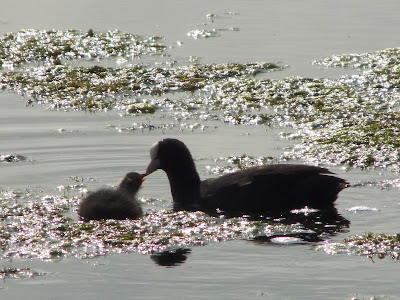These odd looking birds are actually coot chicks.
It's a hard life being a coot chick. Coots tend to have around nine hatchlings but most die within the first 10 days of hatching- and not usually through predation. Coots feed their young on tiny insects and shrimps which means an awful lot of effort to keep a large number of hatchlings happy. After about three days they start attacking the young that beg for food, usually going for the weaker ones. This either kills the chicks or eventually the chicks give up begging and starve to death. Most coots only raise two or three out of nine hatchlings. That's what you call a tough childhood.
I also saw several groups of tufted duck ducklings. One had three young but there was also a large family with a ridiculous seventeen ducklings!
Now I'd like to be able to tell you that these ducklings have a better chance than the coot young but that just wouldn't be right. The reasons these birds have so many young is because so many are predated on. Herons, foxes, birds of prey and fish will all happily take small ducklings. I suspect that the chance of all 17 of this making adulthood is very slim indeed.
I also got a couple of good shots of great crested grebes on the lakes too.
I was lucky to visit Longham during the only period of sunshine we've really had this week, which meant it was ideal weather for seeing insects.
Longham Lakes has become something of a dragonfly haven this year with several more unusual species being seen as well as the very unusual in the UK scarlet darter. I did spot several dragonflies during my visit but the only one I got a clear shot of was this black-tailed skimmer.
I was pleased to see how well the site is being managed for insects with beds of wildflowers most of the way around the lakes. This combined with the weather meant I saw twelve different species within the hour or so I was on the site. Most were species I see regularly such as large whites, red admirals, peacocks and common blues.
I did see several species that I haven't seen yet this year though. One was a clouded yellow but that species is such a fast flyer it's extremely tricky to get a photo of. The other I did get a really clear shot of, a painted lady.
This is a migratory species that comes to the UK from North Africa- it can't cope with UK winters. It's one of the world's most widespread species being present on every continent except South America and Antarctica. It's also the only species of butterfly ever recorded in Iceland, which shows you just how far this species is able to migrate.
I added another species of butterfly to my 2017 list the following day when in the New Forest with this small copper.
This species lives in discrete colonies across the UK and there are usually 3 or 4 generations a year- this is likely a second generation adult.
Not far from this spot I spotted a rosy footman moth.
This is a nocturnal moth though it can be seen in the day on it's favoured woodland hedgerows. They are unique in that they are the only moth with a vivid pink colouring (on the edge of their wings).
Finally, one more butterfly today. It's a very common brimstone but I think this is probably the best photo of a butterfly I've ever taken.
That's all for today but I'll hopefully be back here with a new post on Wednesday! See you then.































































